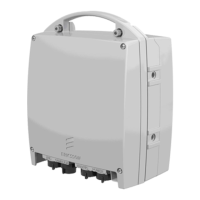6-7 MINI-LINK BAS
EN/LZB 111 0542 P2B Technical Description
• VCI = Subrack number *18 + Slot – 5;
when 2 <= Unit <= 31 (C-AASs (CE Shelves))
• VCI = Subrack number *17 + Slot + 27;
when 32 <= Unit <= 255 (R-AASs (Radio Shelves)).
For example to address a board in slot 2 of the C-AAS (CE shelf)
number 17, the VPI/VCI output from the CP are:
• VPI = 0
• VCI = 17 * 18 + 2 – 5 = 303
If there is a board in slot 4 of the R-AAS (Radio Shelf) number 42, the
VPI/VCI output from the CP are:
• VPI = 0
• VCI = 17 * 42 + 4 +27 = 745
I2 Interface
The basic assumptions are:
• VP = 1 as SN input;
• The VCI range is 32-1055 ([0-31] reserved for ATM to be
compliant with the standards) and it depends only on the board
position, that is, it does not depend from the Subrack number of
the shelf the board belongs to.
• DP boards can be reached maximum on two levels of shelves
downstream (board relay function).
The ATM switch within the network must perform the VP/VC
switching between the two interfaces in both directions.
Both these interfaces shall not be changed to support the board relay
functionality.
Each board has an own VPI, VCI depending only on its position in the
shelf, that is, the same couples are used within any shelf.
Note: The software allows up to 32 different VCIs within each
shelf, but only the first 17 VCI values are used, so far each
shelf contains maximum 19 slots, that is, 17 boards plus
two, maximum, power boards.
For any subrack C-AAS (CE Shelf) and R-AASs (Radio shelves) at
first level, directly connected to the ATM switch, the rule is
following:
• VPI=1
• VCI= 31+ Slot
For example to address a board in slot 2 of the C-AAS (CE Shelf)
number 17, the VPI/VCI output from the CP is:
• VPI = 1

